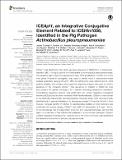Files in this item
ICEApl1, an integrative conjugative element related to ICEHin1056, identified in the pig pathogen Actinobacillus pleuropneumoniae
Item metadata
| dc.contributor.author | Bosse, Janine T. | |
| dc.contributor.author | Li, Yanwen | |
| dc.contributor.author | Crespo, Roberto Fernandez | |
| dc.contributor.author | Chaudhuri, Roy R. | |
| dc.contributor.author | Rogers, Jon | |
| dc.contributor.author | Holden, Matthew T. G. | |
| dc.contributor.author | Maskell, Duncan J. | |
| dc.contributor.author | Tucker, Alexander W. | |
| dc.contributor.author | Wren, Brendan W. | |
| dc.contributor.author | Rycroft, Andrew N. | |
| dc.contributor.author | Langford, Paul R. | |
| dc.contributor.author | BRaDP1T Consortium | |
| dc.date.accessioned | 2016-07-12T15:30:06Z | |
| dc.date.available | 2016-07-12T15:30:06Z | |
| dc.date.issued | 2016-06-15 | |
| dc.identifier | 244262162 | |
| dc.identifier | d8caf049-b7f0-4291-b02c-f5036bd8ac54 | |
| dc.identifier | 000377741800001 | |
| dc.identifier | 84980018882 | |
| dc.identifier | 000377741800001 | |
| dc.identifier.citation | Bosse , J T , Li , Y , Crespo , R F , Chaudhuri , R R , Rogers , J , Holden , M T G , Maskell , D J , Tucker , A W , Wren , B W , Rycroft , A N , Langford , P R & BRaDP1T Consortium 2016 , ' ICE Apl1 , an integrative conjugative element related to ICE Hin1056 , identified in the pig pathogen Actinobacillus pleuropneumoniae ' , Frontiers in Microbiology , vol. 7 , 810 . https://doi.org/10.3389/fmicb.2016.00810 | en |
| dc.identifier.issn | 1664-302X | |
| dc.identifier.other | ORCID: /0000-0002-4958-2166/work/60196447 | |
| dc.identifier.uri | https://hdl.handle.net/10023/9121 | |
| dc.description | This work was supported by a Longer and Larger (LoLa) grant from the Biotechnology and Biological Sciences Research Council (BBSRC grant numbers BB/G020744/1, BB/G019177/1, BB/G019274/1, and BB/G018553/1), the UK Department for Environment, Food and Rural Affairs, and Zoetis (formerly Pfizer Animal Health) awarded to the Bacterial Respiratory Diseases of Pigs-1 Technology (BRaDP1T) Consortium. MTGH was supported by the Wellcome Trust (grant number 098051). JR was funded from the former AHVLA’s Research and Development Internal Investment Fund (grant number RD0030c). | en |
| dc.description.abstract | ICEApl1 was identified in the whole genome sequence of MIDG2331, a tetracycline resistant (MIC = 8 mg/L) serovar 8 clinical isolate of Actinobacillus pleuropneumoniae, the causative agent of porcine pleuropneumonia. PCR amplification of virB4, one of the core genes involved in conjugation, was used to identify other A. pleuropneumoniae isolates potentially carrying ICEApl1. MICs for tetracycline were determined for virB4 positive isolates, and shotgun whole genome sequence analysis was used to confirm presence of the complete ICEApl1. The sequence of ICEApl1 is 56083 bp long and contains 67 genes including a Tn10 element encoding tetracycline resistance. Comparative sequence analysis was performed with similar integrative conjugative elements (ICEs) found in other members of the Pasteurellaceae. ICEApl1 is most similar to the 59393 bp ICEHin1056, from Haemophilus influenzae strain 1056. Although initially identified only in serovar 8 isolates of A. pleuropneumoniae (31 from the UK and 1 from Cyprus), conjugal transfer of ICEApl1 to representative isolates of other serovars was confirmed. All isolates carrying ICEApl1 had a MIC for tetracycline of 8 mg/L. This is, to our knowledge, the first description of an ICE in A. pleuropneumoniae, and the first report of a member of the ICEHin1056 subfamily in a non-human pathogen. ICEApl1 confers resistance to tetracycline, currently one of the more commonly used antibiotics for treatment and control of porcine pleuropneumonia. | |
| dc.format.extent | 8 | |
| dc.format.extent | 754334 | |
| dc.language.iso | eng | |
| dc.relation.ispartof | Frontiers in Microbiology | en |
| dc.subject | Animal infections | en |
| dc.subject | Antibiotic resistance | en |
| dc.subject | Respiratory tract | en |
| dc.subject | Conjugation | en |
| dc.subject | Pasteurellaceae | en |
| dc.subject | R Medicine | en |
| dc.subject | QR Microbiology | en |
| dc.subject | NDAS | en |
| dc.subject.lcc | R | en |
| dc.subject.lcc | QR | en |
| dc.title | ICEApl1, an integrative conjugative element related to ICEHin1056, identified in the pig pathogen Actinobacillus pleuropneumoniae | en |
| dc.type | Journal article | en |
| dc.contributor.institution | University of St Andrews. School of Medicine | en |
| dc.contributor.institution | University of St Andrews. Infection Group | en |
| dc.contributor.institution | University of St Andrews. Biomedical Sciences Research Complex | en |
| dc.identifier.doi | 10.3389/fmicb.2016.00810 | |
| dc.description.status | Peer reviewed | en |
This item appears in the following Collection(s)
Items in the St Andrews Research Repository are protected by copyright, with all rights reserved, unless otherwise indicated.

